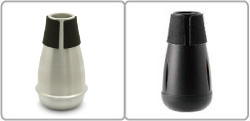
It’s THE next-generation stop mute.
‘PotStop’ is a stop mute whose feature is truly one-of-a-kind. This mute allows you to play stopping with a regular fingering on a score and also can be used for F, Bb, F/Bb double horn, and now even for Vienna horns!
When we first developed the ‘Non-transposing’ stop mute back in 2003, the concept itself was actually for students. However, in reality, it was surprisingly accepted mostly by professionals and currently used in many major orchestras such as Vienna Philharmonic Orchestra.
Some features of the new model are based on and developed by taking in dialogues with the players who actually uses the past ‘Non-transposing’ mutes for years. The quality is further advanced and exceeds the past models at any points, and here, PotStop is newly-born as a truly professional stop mute.
Main features
Comfortable throughout the registers.
Not only do general stopping mutes have botheration of the alternative fingering, but also it is quite difficult to play comfortably because of its stuffy sound.
The natural feel and well-sounding timber of PotStop are achieved by setting a new design concept that “sings with Horn”, while the others only eject the isolated stop sound from the fully-muffled bell. Along with other trustful factors such as pitch, intonation, and an ease of low registers, PotStop is just so comfy to play.
Powerful, loud, and brassy stop sound.
The design approach of PotStop is not like any of the others, and it actually does not completely “stop/close” the bell. With this and the beautifully polished brass top, PotStop projects one of the loudest, most powerful, and the brightest brassy-sound in the market. Besides, lower harmonic overtones are blended by a copper material of the hidden inner bell(fig.1), which makes the open sound become even richer and more HandStop-like.
Also as Warm-up mute
Here is one more feature we should share. If you play PotStop softly, you can use it as Warm-up/practice mute as it just makes peaceful sound at the softer level. Also, it actually has a great advantage that you can easily control/adjust the resistance with your right hand by opening or closing the top bell of PotStop.
In case you would need a stop sound at the softer level, push PotStop into the bell a little bit more than usual position, and it will start buzzing. Or, on the other hand, pulling the mute a little, then the sound will be even more powerful and handstop-like. It will definitely be worth exploring some position.
Development Story
Request from Mr.Wolfgang Tomböck
The development of the new model started when we got a request from Mr.Wolgang Tomböck for ‘Non-transposing Gestopft’ for Vienna Horns. In the e-mail, it was written that the stop mute they were using had an issue on intonation and that every horn players in the VPO, Volksoper, Tonkünstler, and Vienna Symphony wished a non-transposing stop mute for their Vienna horns.
The direction of the new model
This unanticipated offer was totally surprising, but we immediately decided challenging it as we all at Best Brass had known that it would be such an honorable work to do it.
At the beginning of the development, we were drawing a special mute for Vienna horns, however, it was more fascinating for us to make a new stop mute which can be used for F, Bb, F/Bb double, and also Vienna horns. We made a first prototype and brought it to their Japan tour. Although the mute was not-so-great, to set the direction of the new model, it was really helpful enough that putting it in their horns, measuring this or that, and actually listening/hearing through their instruments and talks.
The birth of PotStop
The design of the new model was almost set at the second trial piece. In fact, it already got good marks from Mr.Tomböck, but we added some further improvements last on details and finish, and then, the specification of the ‘new model’ was all set.
As a matter of fact, the thing that troubles us the most was the product name. We finally named it as ‘PotStop’, which is composed of the mute’s totally distinguishing exterio, a friendly(yet slightly slangy) vibrancy, and the cool-looking letters.
About the Stopping
What is stopped horn? What is transposing?
Stopped horn is a technique of "muting" the horn with the right hand. It gives a unique metallic sound. When you play stopped, the note will be half step higher on the F side of your horn and approximately 3/4 higher on B♭side. Therefore, you will need to use the fingering for the note that is a half step lower than the written note on F side, and some B♭horn has a stopping valve to transpose it.
Why do we put right hand in the bell?
Putting right hand in the bell is a unique play style of Horn, but this is related to the development of the instrument.
Beethoven wrote his horn sonata for natural horns because they still were in the main stream at that moment. In the sonata, however, there actually are some notes that cannot be played without a valve system. In fact, players of that time were able to play the song without any valve systems. They had a special skill and controlled pitch or intonation by using a different shape and a place of their right hand.
Now, it actually is not necessary to master that skill because most of the current horn has a valve system, but the right hand may be described as a trace of those styles. However, it is true that present top hornists are acquiring the special skills, and those skills are still required in some songs. Indeed, it sounds like the world’s hardest instrument to play. (*)
* The Guinness World Book of Records
The usage of stop mutes
It acquires a lot of practices to master stopped horn and actually is hard to play it for many amateur horn players. Besides, playing stopped horn in low registers sometimes is hard for even professional hornists. Therefore, stop mutes are often used.

- ・Easy high note
- ・Stable low register
- ・Great endurance
- ・Clear articulation
- ・Dignified sound
- ・Precise pitch
Click here to reach the new level of mouthpieces.





